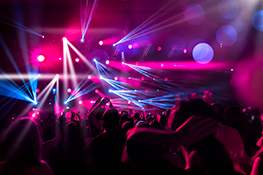LED Strip Lighting for Stages: Creative Uses & Installation Guide
Stagelights.in
Introduction: Beyond the Basics of Stage Lighting
LED strip lighting has rapidly evolved from a simple accent to a powerful tool for stage designers and lighting technicians. Its versatility, energy efficiency, and affordability have made it a staple in modern stage productions, offering endless creative possibilities beyond traditional stage lighting fixtures. This comprehensive guide dives into the creative applications and practical installation of LED strip lights on stages, equipping you with the knowledge to transform your stage designs.
Creative Applications of LED Strip Lighting on Stage
Dynamic Backlighting & Set Enhancement:
LED strips can be seamlessly integrated into set pieces, backdrops, and even the stage floor to create dynamic backlighting effects. Their flexibility allows for intricate patterns and color changes, subtly enhancing the mood and atmosphere. Control systems, from simple DMX controllers to advanced software solutions, allow for precise synchronization with the performance.
Accent Lighting & Feature Highlighting:
Use strategically placed LED strips to highlight specific actors, props, or set elements. This targeted illumination can draw the audience’s eye, creating focal points and enhancing visual storytelling. Color temperature and intensity adjustments offer subtle yet impactful control over the focus and mood.
Creating Immersive Environments:
Extend the stage environment beyond its physical boundaries using LED strips. Concealed strips around the stage perimeter can project light onto walls or curtains, expanding the stage’s visual impact and creating an immersive atmosphere for the audience. Color washes and dynamic effects can further enhance this immersive experience.
Special Effects & Dynamic Lighting Sequences:
Programmable LED strips offer a cost-effective way to achieve impressive dynamic lighting sequences. From pulsing rhythms to choreographed light shows, these strips enable creative freedom in designing unique lighting effects that complement the performance’s theme and energy.
Choosing the Right LED Strip Lights for Your Stage
Brightness & Color Temperature:
Selecting the right brightness (lumens) and color temperature (Kelvin) is crucial. Consider the size of your stage and the overall lighting design. Cooler temperatures (higher Kelvin) are often used for bright, energetic scenes, while warmer temperatures (lower Kelvin) create a more intimate and relaxed ambiance. Addressable RGB strips offer the most control and creative possibilities.
IP Rating & Durability:
Stage environments can be demanding. Choose LED strips with a suitable IP rating (Ingress Protection) to protect against dust and moisture. A higher IP rating ensures durability and longevity, especially if your stage is exposed to potential spills or weather conditions.
Power Supply & Controllers:
Ensure that you select a power supply capable of handling the total wattage of your LED strips. Consider using multiple power supplies for larger installations to avoid voltage drops and ensure consistent brightness. Choose a DMX controller or other compatible lighting control system that suits your needs and budget.
Installation Guide for Stage LED Strip Lighting
Planning & Design:
Before starting, meticulously plan the placement and routing of your LED strips. Consider the overall lighting design, power requirements, and accessibility for maintenance. Sketching a diagram can be incredibly helpful.
Mounting & Securing:
Use appropriate mounting methods depending on your chosen surfaces. Adhesive backing is convenient for many applications, but mechanical fasteners may be necessary for more robust installations. Ensure secure mounting to prevent damage or detachment during use.
Wiring & Connections:
Carefully connect the power supply, LED strips, and controller. Follow the manufacturer’s instructions precisely to ensure proper functionality and prevent damage. Use appropriate connectors and ensure all connections are secure and properly insulated.
Testing & Calibration:
After installation, thoroughly test the entire system. Check for proper functionality, brightness levels, and color accuracy. Calibrate your controllers to achieve the desired lighting effects and ensure seamless integration with other stage lighting.
Conclusion: Unleash the Creative Potential of LED Strip Lighting
LED strip lighting offers a versatile and cost-effective solution for enhancing stage productions. By understanding its creative applications and mastering the installation process, you can elevate your stage designs and bring your artistic vision to life. Explore the endless possibilities and let your creativity shine!


 Auditorium Construction Services
Auditorium Construction Services 